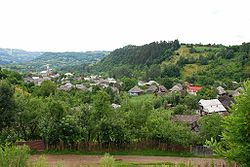Săcel, Maramureș
| Săcel | |
|---|---|
| Commune | |

View of the village
|
|
| Coordinates: 47°38′42″N 24°23′42″E / 47.64500°N 24.39500°ECoordinates: 47°38′42″N 24°23′42″E / 47.64500°N 24.39500°E | |
| Country | Romania |
| County | Maramureș |
| Elevation | 400 m (1,300 ft) |
| Time zone | EET (UTC+2) |
| • Summer (DST) | EEST (UTC+3) |
Săcel (Hungarian: Izaszacsal, Yiddish: סיטשל) is a commune in Maramureș County, Romania. Composed of a single village, Săcel, it is the last locality up the Iza Valley. From here one can get to the Vişeu Valley through Dealul Moiseiului Pass (towards the northeast) and to Transylvania (specifically Năsăud, towards the south) through Dealul Ștefāniței Pass, which separates the Țibleș and Rodna Mountains.
Săcel is famous for its red, unglazed pottery obtained through ancient, Dacian techniques that date back more than 2000 years ago. Nowadays, an ancient Roman type oven is used for burning the clay. Săcel pots are manufactured in Dacian style and they are ornamented using mineral elements. The ornaments are simple and resemble natural elements (the flow of water, the sun, the line of life, folkloric motifs). These elements were also used in the Dacian ceramics.
The ceramist Tănase Burnar from Sācel belongs to a family in which pottery making was transmitted from generation to generation. He is the son of Tănase Cocian, the famous craftsman. Tănase Burnar is familiarised with the potter's wheel since he was 10, when he started to make his first objects. Now he makes with great skill ceramic plates, pots, cups and jugs burned once in the oven. The oven uses wood fire so the colour of the clay is preserved. The clay used is kaolin, a fine and dense clay taken from deep springs (10-15m) in Drobodeava Hill, Săcel.
Săcel pottery made using ancient, Dacian techniques
Săcel pot
Viaduct
Tănase Cocian with his son and grandson
Mask made by Vasile Șușca
Vasile Șușca
...
Wikipedia
